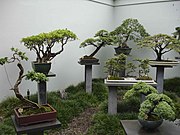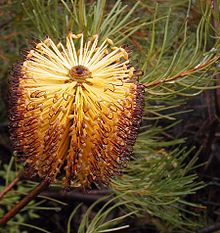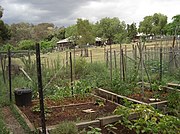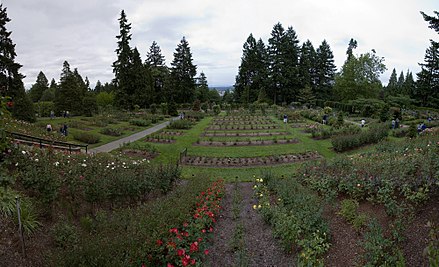From Wikipedia, the free encyclopedia
Tools

A set of bonsai tools, from left to right: leaf trimmer; rake with spatula; root hook;
coir brush; concave cutter; knob cutter; wire cutter; small, medium, and large shears
Special tools are available for the maintenance of bonsai. The most common tool is the concave cutter, a tool designed to prune flush, without leaving a stub. Other tools include branch bending jacks, wire pliers and shears of different proportions for performing detail and rough shaping. Anodized aluminum or copper wire is used to shape branches and hold them until they take a set.
Fertilization and soil
Opinions about soil mixes and fertilization vary widely among practitioners. Some promote the use of organic fertilizers to augment an essentially inorganic soil mix, while others will use chemical fertilizers freely. Bonsai soils are constructed to optimize drainage. Bonsai soil is primarily a loose, fast-draining mix of components, often a base mixture of coarse sand or gravel, fired clay pellets or expanded shale combined with an organic component such as peat or bark. In Japan, volcanic soils based on clay (akadama, or "red ball" soil, and kanuma, a type of yellow pumice) are preferred.
Containers
Every bonsai pot is equipped with drainage holes to enable the excess water to drain out. Each hole is typically covered with a plastic screen or mesh to prevent soil from escaping. Containers come in a variety of shapes and colors (glazed or unglazed). The ones with straight sides and sharp corners are generally better suited to formally presented plants, while oval or round containers might be used for plants with informal shapes. Most evergreen bonsai are placed in unglazed pots while decidous trees are planted in glazed pots. It is important that the color of the pot compliments the tree. Bonsai pots are produced all over the world, some are higher quality than others and some are highly collectable such as ancient Chinese or Japanese pots made in highly touted regions with experienced pot makers such as Tokoname, Japan. However, highly collectable pots are not just confined to Asia, European Artists such as Byran Albright and Gordon Duffett produce unique pots which Bonsai artists collect.
Pre-Bonsai material are often placed in "growing boxes" which are made from scraps of fenceboard or wood slats. These large boxes allow the roots to grow more freely and increase the vigor of the tree. The second stage after using a grow box is to plant the tree in a "training box" this is often smaller and helps to create a smaller dense root mass which can be more easily moved into a final presentation pot.
Location
Contrary to popular belief, bonsai are not suited for indoor culture, and if kept indoors will most likely die. While certain tropical plants (Ficus, Schefflera, etc.) may flourish indoors, most bonsai are developed from species of shrubs or trees that are adapted to temperate climates (conifers, maples, larch, etc) and require a period of dormancy. Most trees require several hours of direct or slightly filtered sun every day.
Overwintering
Some trees require protection from the elements in winter and the techniques used will depend on how well the tree is adapted to the climate. During overwintering, temperate species are allowed to enter dormancy but care must be taken with deciduous plants to prevent them from breaking dormancy too early. In-ground cold frames, unheated garages, porches, and the like are commonly used, or by mulching the plant in its container up to the depth of the first branch or burying them with the root system below the frost line.
Mallsai
Inexpensive bonsai trees often sold in chain stores and gift shops are derisively referred to as "mallsai" by experienced bonsai growers, and are usually weak or dead trees by the time they are sold. Often these bonsai are mass produced and are rooted in thick clay from a field in China. This clay is very detrimental to the bonsai, as it literally suffocates the roots and promotes root-rot. Very little if any shaping is done on mallsai, and often the foliage is crudely pruned with little finesse to resemble a tree. Due to the conditions under which they are transported and sold, they are often inadequately watered and are kept in poor soil, usually a clump of sphagnum moss or the aforementioned clay with a layer of gravel glued to the top, which leaves them susceptible to both drying and fungal infections. Some "mallsai" can be resuscitated with proper care and immediate repotting, although this is reportedly rare. This top layer of glued-on gravel should be immediately removed once the bonsai is purchased, and the plant should be repotted in a good bonsai soil such as akadama.
Collecting
Bonsai may be developed from material obtained at the local garden center, or from suitable materials collected from the wild or urban landscape. Some regions have plant material that is known for its suitability in form - for example the California Juniper and Sierra Juniper found in the American West, and Bald Cypress found in the swamps of Louisiana and Florida.
Collected trees are highly prized and often exhibit the characteristics of age when they are first harvested from nature. Great care must be taken when collecting, as it is very easy to damage the tree's root system (often irreparably) by digging it up. Potential material must be analyzed carefully to determine whether it can be removed safely. Trees with a shallow or partially exposed root system are ideal candidates for extraction. There is a legal aspect to removing trees, so the enthusiast should take all steps necessary to ensure permission from the owner of the land before attempting to harvest. If not, consider the right of the plant to stay where it is undisturbed..
Bonsai tourism
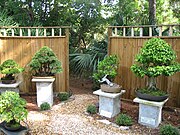
A collection of bonsai at Florida's Melbourne Zoo.










